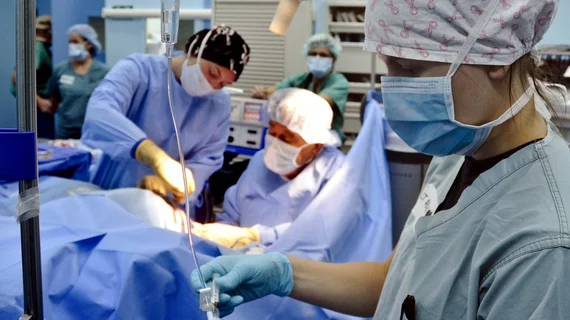Surgeons and other interventionalists who tapped an academic radiology department’s 3D printing service to plan and practice upcoming procedures saved almost half an hour per operation over the course of a year, according to a study published online Aug. 18 in JACR [1].
The print clients also saved money for their institution, the University of Cincinnati Medical Center, spending around $2,200 per printed model where it would have cost close to $2,500 had the service been outsourced to a vendor.
Radiology researchers Prashanth Ravi, PhD, Frank Rybicki, MD, PhD, and colleagues estimate their fledgling in-house 3D print shop saved almost $3,000 per patient in operating-room costs thanks to the shortened procedure times.
The team concentrated the service’s performance evaluation on 68 anatomic models ordered over 12 months for consecutive patients who went on to have a procedure for any of 11 clinical indications. (Another 10 orders were placed for patients who ended up not having a procedure.)
Findings Exploratory but Instructive
Along with estimating the print center’s returns on investment, the researchers had physicians who ordered 3D printouts use five-point Likert (agree/disagree) scores to grade the clinical utility of the models from 0 to 500 in seven questions:
- The 3-D printed model or guide was easy for me to use.
- Use of the 3-D printed model or guide was compatible with other aspects of my approach to this case.
- As a result of using the 3-D printed model, the treatment plan was altered or refined.
- Use of the 3-D printed model or guide was important in this case.
- The quality of the 3-D printed model or guide was adequate.
- Before using the 3-D printed model, I was confident in the treatment plan.
- After using the 3-D printed model, I was confident in the treatment plan.
The referrers’ total utility scores ranged from 200 to 450 points with an overall mean of 312.
Reporting that the total cost to operate the print facility over the one-year window was $213,450, Ravi and co-authors comment that assessing utility and cost benchmarks for anatomic models 3D printed in a hospital “can inform healthcare budgets.”
At the same time, they acknowledge that additional research will be needed to understand how much an institution might save in real dollars.
Procedure Room Time Saved: A Benchmark for Future Research
In their discussion the authors note that they considered the first year of their 3D print operation to include typical start-up resources—desktop 3D printers, one workstation and “modest human resource assignments.”
“Each hospital experience will vary; ours began with mostly cardiovascular patients but then expanded to include other indications,” they comment, adding that year-over-year costs also will vary.
“On one hand experience will favor operational efficiency; on the other hand, requests for more complex models to include flexible materials or multiple colors may require higher capital expenditures,” they continue. “Medical 3D printing could also provide an alternative revenue source if other hospitals rely on the clinical service for their patient care.”
Describing limitations in study design, the authors state the service was used in complex cases, including malignant tumors and cardiovascular diseases, for which connecting 3D modeling with ultimate outcomes is difficult if doable at all.
More from Ravi et al.’s discussion:
Procedure room time saved is a benchmark for future research. The reported time saved translated to $2,900 per case, but potential savings remain theoretical. As schedules are modified for more procedures over a fixed period, additional revenue may be realized. The in-hospital service fostered clinical consultations considered highly valuable. These in-house consultations increased confidence in determining and rehearsing surgical approaches.”

